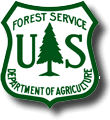United States
Department of
Agriculture
Forest Service
Rocky Mountain
Research Station
Ft. Collins, CO
General Technical Report
RMRS-GTR-118-CD
February 2004
| Authors |
| Acknowledgments |
| Introduction |
| Species description format |
| Trees |
| Shrubs |
| Ferns & Friends |
| Forbs |
| Graminoids |
| Descriptive drawings |
| Collecting and pressing methods |
| Glossary |
| References |

Collecting and pressing methods
Collecting and pressing plants is an excellent way to learn the various species of an area. We suggest that each Forest Supervisor's Office and Ranger District have a collection of indicator species, similar "confuser" species, and other common species. Mounted specimens, along with color photographs, make ideal visual teaching aids when fresh material is not available. Dried specimens and collection site habitat data also serve as a source of information about geographical distribution, species variation, habitat and miscellaneous information,When collecting plants, especially on private property, seek the permission of the landowner. All National Parks and Monuments require a permit. Be discrete with the number of plants you collect; never take the only plant, leave a healthy population behind. Rare and endangered plants exist in northern Idaho and should NOT be collected. You can learn more about northern Idaho species covered under the Endangered Species Act of 1973 by consulting FWR Bulletin No. 34, Vascular Plant Species of Concern in Idaho, 1981. Information on their occurrence and location should be sent to the Herbarium Manager, Stillinger Herbarium, Dept. of Biological Sciences, University of Idaho or to any member of the Rare and Endangered Plant Technical Committee.
The following suggestions should aid you in making plant collections. Accurate identification of a collected specimen requires careful selection in the field. Collect average specimens [not too small or too large) or collect several to show variations. Select specimen free of insect or pathological damage. Collect plants in flower, fruit, and/or seed (some species require all three stages for accurate identification). Collect the entire plant including stems, different leaf forms and underground parts. If that is not possible, carefully describe the plant, noting pertinent descriptive characteristics. Collected plant material should be immediately placed in a plant press. Because presses are not standard field gear, a dampened specimen can be kept in a plastic bag until it can be placed in a press. The plastic bag should be inflated slightly for added protection during travel.
A plant press is used to quickly dry and preserve fresh material. A good press consists of blotters separated by corrugated cardboard sheets, held between wooden lattices and tightly bound with straps. The corrugated sheets allow for air circulation and permit drying of the plants without discoloration or spoilage. A temporary press can be improvised out of an absorptive book, e.g., phone book or magazine.
Care should be taken in placing the collected specimen in the press. Several small plants may be placed on one sheet, but crowding should be avoided. Flowers and fruits should be clearly visible. Flower color and any other characteristics which will be lost in pressing should be noted with the site information. Leaves should be laid flat with one or two leaves turned to show underside characteristics. A large specimen may need to be pruned to avoid overlapping. When pruning an overlapping part, a small piece should be left on the specimen to indicate its removal. A neat and careful arrangement cannot be overstressed. Poorly pressed specimens require additional time to identify, or may not be identifiable.
Drying time will vary between specimens. After three days, check the specimens and replace any moist blotters with dry ones. Exposing the press to sun and a breeze will hasten the drying. After a specimen is dried, it is ready to be mounted or mailed in a cardboard reinforced envelope to a herbarium for identification. Specimens may be sent to the University of Idaho Herbarium for identification or verification.
Herbarium Manager
Stillinger Herbarium
Dept. of Biological Sciences
University of Idaho
Moscow, ID 83843
Accurate and complete site information must be taken at the time of collection and recorded in a collection notebook with reference to the specimen number. Types of information to record are:
- scientific name (if known)
- locality: place name, legal description, county, State, National Forest
- elevation, aspect, slope
- vegetation type, preferably habitat type
- microsite (area around plant)
- abundance and distribution
- soils (parent material, depth, structure, texture, and so forth)
- notes on plant: size, fresh color, inflorescence (if destroyed in pressing)
- date of collection
- name of collector
USDA Forest Service
NORTHERN IDAHO VOUCHER COLLECTION
Family _____________________________________________ Herbarium No. ________________
Scientific Name ___________________________________________________________________
State ____________ County ________________ NF & RD ________________________________
Location _______________________________________ T. ___ R.____ Sec. _____ 1/4______
Elevation ______________Slope ____________ Aspect _____________Plot No. ___________
Habitat Type ______________________________________________________________________
Current Vegetation Type ___________________________________________________________
Microposition _____________________________________________________________________
Principal Associated Species ______________________________________________________
Size: Ht. ______ Dia. ______ Soil _________________________________________________
Notes: ____________________________________________________________________________
Collected by ______________________________________ No: _______ Date:______________
Confirmed by __________________________________________________ Date: _____________